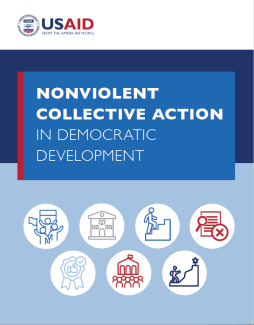Throughout history and in every corner of the world, nonviolent collective action has been central to ending wars and building peace, securing labor rights and environmental protections, opening entire regions to democracy, shifting norms and laws about human rights, expanding electorates, and provoking individuals’ imaginations of what is politically possible in their societies. And during the most recent decade, more people than ever before engaged in grassroots organizing, social movements, and other forms of nonviolent collective action. USAID policy and programming will be enriched by a deep understanding of nonviolent collective action due to its catalytic effect on democracy and development globally.
Nonviolent collective action is not only ubiquitous, it is also effective. Political transitions initiated through nonviolent collective action have been three times as likely to lead to democracy as political transitions initiated through all other means. And nonviolent collective action has curtailed corruption and sparked democratic innovations on multiple continents. Labor unions, religious organizations, and professional associations have been particularly powerful players in nonviolent collective action.
Nonviolent collective action is a core strategy of civic participation that touches every aspect of society. It involves regular people building power collectively in their societies and applying that power to bring about meaningful political, social, or economic change without the threat or use of violence. It often involves communities that have been historically excluded from power, building political power in their society and using that power to change hearts, minds, and policy. In some contexts, this entails grassroots organizing by informal groups at the local level. In other contexts, it entails creating a social movement at the national level. In some contexts this entails civil disobedience. And in many contexts it involves relationship building, training and leadership development, coordination and coalition building, and innovative and resilient action.
To date, USAID’s support for nonviolent collective action has focused on: protecting and expanding civic space, labor organizing, as well as ad hoc and opportunistic initiatives in key countries. Looking forward, USAID has an opportunity to expand this work transnationally, such as regional and global activities, given its network of missions and partners in nearly every corner of the world. Also, deeper USAID engagement and coordination in multilateral contexts and with non-governmental donors that support nonviolent collective action would often be welcomed.
In many contexts, USAID is well placed to continue to help expand and protect the online and offline civic space ecosystem. In some contexts, USAID is able to offer indirect support to nonviolent collective action via educational materials and training that strengthens local leadership, organizing capacity, nonviolent discipline, agency, and resilience. USAID’s Office of Transition Initiatives is well placed in many contexts to support resilience in the face of repression, and to otherwise respond to the urgent needs of those engaged in nonviolent collective action.
It is critical that USAID coordinate its support for nonviolent collective action with other U.S. government, bilateral, and non-governmental partners. Coordination is not always easy. But it should not be assumed or be an afterthought since the lack of coordination can be particularly dangerous to organizers and harmful to movements’ chances of success.
Five actionable recommendations reflect the untapped possibilities for USAID to more effectively promote democratic development through support for the nonviolent collective action ecosystem. Critically, USAID should prioritize the guidance of organizers and movement leaders when it comes to ensuring that our engagement does no harm and supports their work in the manner and the moments that are most helpful.

